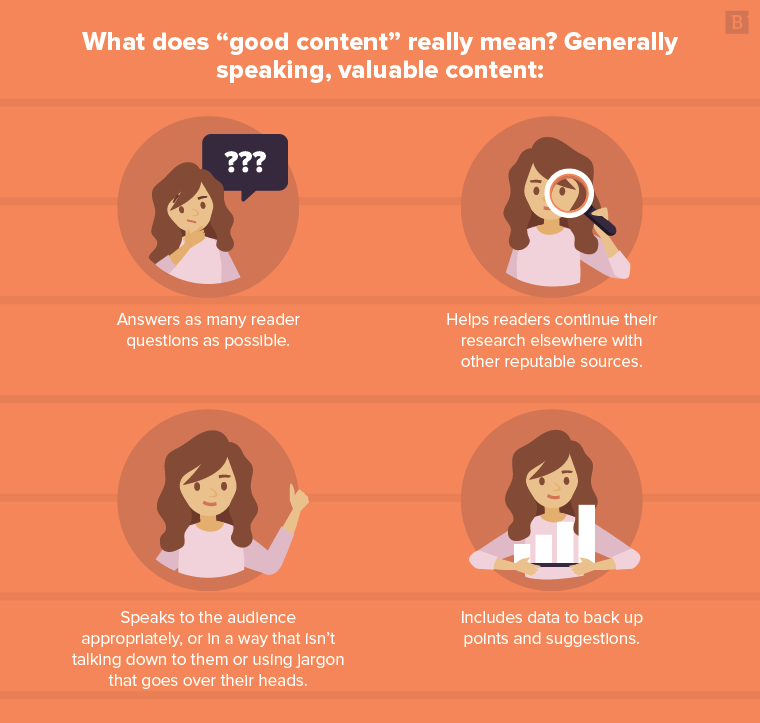It’s a question asked by writers and content marketers everywhere. The answer is elusive. Google this question, and you’ll get numbers across the board, and none of them seem conclusive.
- Yoast will tell you that you won’t rank on Google if your post has fewer than 300 words.
- Neil Patel says it depends on the industry; if you’re in tech, aim for a longer post, between 800 and 1,000, but if you’re in real estate, try for 1,800 and 1,900.
- Unsettle says the perfect number is 2,000, with one caveat: the entire article needs to be valuable to the reader.
The truth is, all of these are partly right. The other truth — one that’s either liberating or frustrating (or both) — is that the right word count depends on your content and goals.
Understanding Your Content Goals
Generally speaking, the goal of blog content in digital marketing is to bring people to your website so you can show them how helpful you are.
But your goals go beyond that. You might write a piece you hope will generate a lot of social media shares, or a piece that will become the go-to guide for solving a niche problem in your industry.
Understanding your content marketing goals is one way you can begin tailoring your blog post length to meet them.
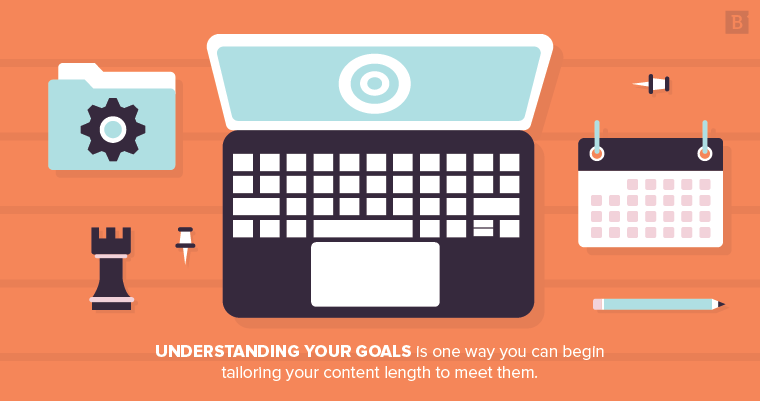
Goal: SERP Ranking
If you’re aiming to rank for keywords to increase organic traffic to your site (and you probably are), long blog posts are generally the way to go. On the first page of Google, the average word count is 1,890, according to a study by Backlinko. Longer articles support SERP success in a few ways.
For search engines to rank you higher in a search result, your content needs to be valuable to readers. They can only make that determination if you have enough content to demonstrate that you know what you’re talking about. The longer your articles are, the more context search engines will have and the more likely they’ll identify your pieces as worthwhile (granted they actually are, of course).
Content that is about 500 words or longer will require additional structural elements within the blog, like subheadings and images, to break it up. Without HTML tags and design cues, articles become seas of gray text incapable of holding readers’ attention. Plus, with no visual anchors or points of reference, it’s easy to get lost in that sea. Subheads and image alt text provide search engines further context about your content.
All of this is considered on-page search engine optimization, which should help you rank higher. Behind-the-scenes SEO like creating an informative meta description and title tag can also help your SERP rankings.
When you write longer blogs about a given subject, you’ll usually end up with a more comprehensive article. It’s more likely to address your audience’s specific search queries, and that means they’ll stay on your page for longer. Google notices which pages readers are spending their time on (through metrics like dwell time, bounce rates, the number of unique sessions per page, among others) and rewards those pages.
Finally, the more you write about a particular search query, the more two things will happen:
- You’ll use the keyword more often in a natural way that doesn’t look like keyword stuffing (because it’s not).
- You’ll hit other long-tail keywords that relate to the topic – some of which may not have been on your radar until now.
Though it’s generally accepted that longer content will perform better in SERPs, this rule of thumb isn’t perfect. In a guest post for Moz, we pointed out that our research showed otherwise. We looked at how word count correlated to keyword position, as well as how word count correlated to additional keyword ranking (outside the targeted keyword). In both cases, word count didn’t make a difference.
Granted, all cases in the data we took into consideration were blog posts with word counts of at least 900 words. We weren’t analyzing 300- or 500-word articles. Could this have made a difference? In the article, we ponder whether Google has a long-form threshold that’s lower than 900 words, above which there is no added value for more content (in rankings, at least). We doubt it, but there’s always that possibility.
Goal: Social Shares
A good social media strategy supports your blog by keeping your content top of mind, engaging with your readers or customers and taking advantage of the many paths people may take to find your website.
To optimize your content for shareability, it’s best to err on the longer side.
A BuzzSumo analysis found that articles between 3,000 and 10,000 words were shared most often, with 8,859 shares on average. A shorter blog post of about 1,000 words or fewer got less than 5,000 shares on average. Buffer similarly found that blog posts that were 2,500 or more words received vastly more social shares than those under 2,000 words.
When aiming for more social shares, there does seem to be a threshold beyond which content length can be a detriment, according to another study from Backlinko. Beyond the 2,000 word mark, social media shares seemed to drop, and they did even more so after 3,000 words.
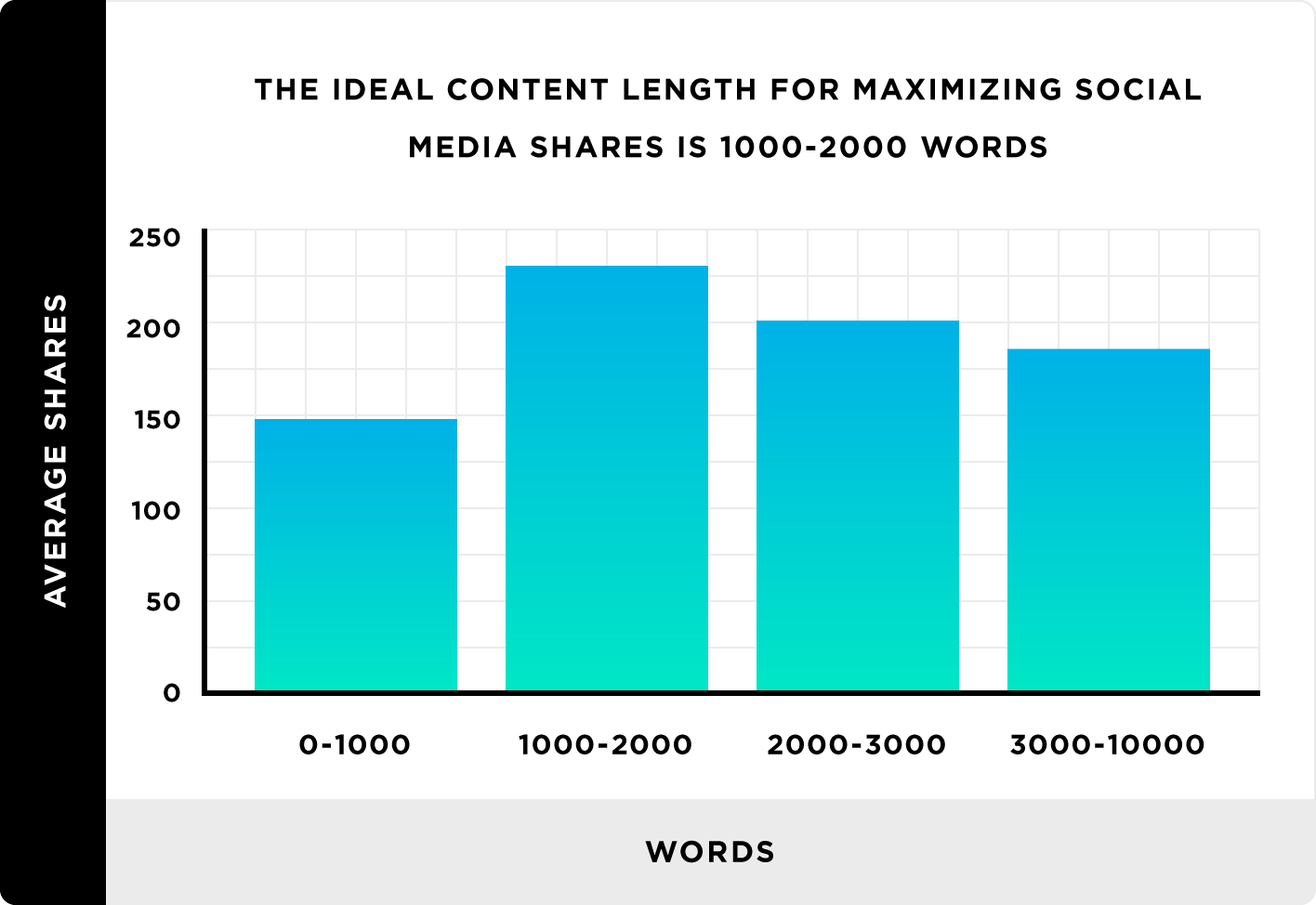
A unique aspect of social media shares is the fact that people often don’t read the articles before they share – at least not in their entirety. One study found that 59% of people don’t click on article links before sharing them on social media.
What does this tell us?
People share based on perceived value. They read the headline and perhaps even the description, then share based on their personal opinions and preconceived notions.
People share based on perceived value.
Even when people click on articles, they typically don’t read the whole thing. Only 20% of people finish the articles they begin, and the average person only reads 25% of articles, according to Sumo. Instead, they skim and scroll.
That’s where subheads, images, charts, bulleted lists and other easy-to-consume elements benefit your content. The more value a person perceives just by glancing at the blog post title, headlines and other features, the more likely they’ll share it.
Goal: Backlinks
A strong backlink portfolio is an important part of an inbound marketing strategy. More backlinks generally lead to better search visibility and increased direct traffic to your site.
Helpful and interesting content that is worthy of a backlink is the best starting point for building a backlink profile. Like any of the other goals in this list, the No. 1 most important factor is content quality.
But blog length seems to play a role in earning backlinks as well, according to another study conducted by Backlinko. In a study of 912 million blog articles, long posts got 77.2% more backlinks, on average, than shorter content.
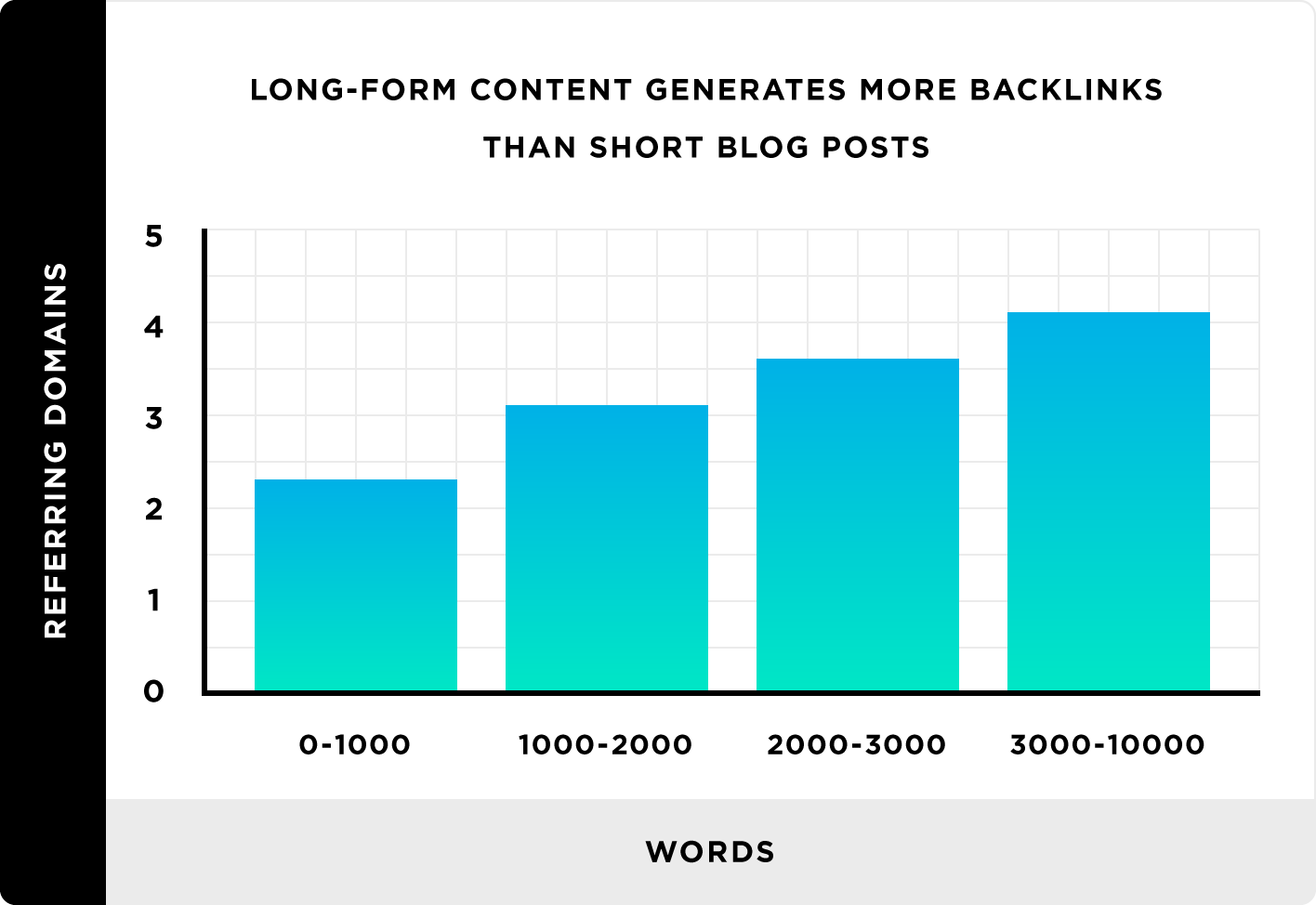
The competition for earning backlinks organically is tough: 94% of all blog posts don’t have a single one. For that reason, when aiming to enhance your backlink portfolio by creating meaningful, interesting content, it’s essential you consider all potential factors at play.
It’s important to note that approaching content creation to gain social shares is fundamentally different than doing so to bolster your backlink profile. There’s little to no correlation between a high number of social shares and a high number of backlinks. So, when defining your goals for your content, be specific.
Goal: Thought Leadership
Establishing your company as a thought leader in your industry is a great way to gain respect and customers alike. And content marketing is one method to demonstrate your leadership. Long posts can support your case that you are knowledgeable and trustworthy.
Long-form content can support your case that you are knowledgeable and trustworthy.
In many cases, it’s easier to include more research and insight in long-form content than shorter content. If you’re limited on words, you’re simply going to have to leave out some details. Conversely, if you can write a blog post that is well-constructed and comprehensive, you could include all aspects around a subject. If you’re addressing a particularly multifaceted topic, you’ll only be able to touch on all the important points if you give yourself the room to do so.
Consider the article, “8 Clever Newsletter Ideas To Wow Your Audience” that Chelsey Church wrote for the Brafton blog. At 1,839 words long, it’s quite the read. But Chelsey provides relevant, helpful information for anyone trying to improve or create their company newsletter. She not only uses this article to point out ideas and examples, but also information about why they work.
Using Data to Dictate Blog Length
As with any other aspect of your content — like subject, tone and the types of images you use — word length depends on your specific target audience preferences. Do your readers typically like long-form content, or are they more likely to engage in a shorter blog post?
The best way to gather this information is by observing the performance of your own content. Use Google Analytics to see how people interact with your articles of varying lengths. If you see high bounce rates on longer articles — or shorter ones — that could potentially be a sign you need to adjust your word counts.
Don’t confuse correlation with causation, though.
There could be a number of factors that make your readers close a tab. Consider things like content quality, site speed (if a mid-article graph never loads, or loads slowly, it’s going to result in poor user experience), the number of images you use and the structure of your article.
You can also turn to data from other sources to guide your word counts, too. As Neil Patel pointed out, his own observations indicate that certain industries do better with longer articles than others. Content about gadgets, for example, performs well when it’s between 300 and 500 words. Fashion also has lower word counts: between 800 and 950.
On the opposite end of the scale, marketing and advertising-related content does best between 2,500 and 3,000 words. Sales also has longer word counts: between 2,500 and 2,700.
There are tools you can use to help determine how many words your blog should be for the most SEO value. Semrush’s SEO Content Template gives you recommendations based on your top 10 rivals in Google for that keyword.
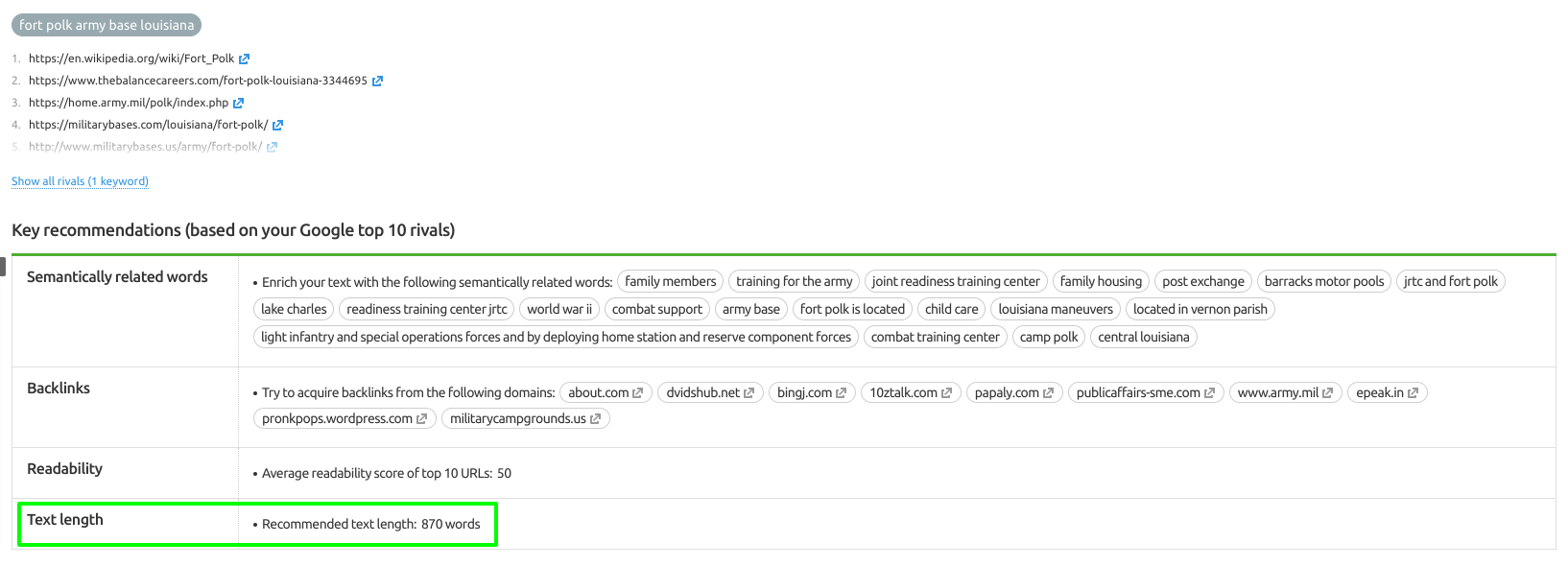 MarketMuse will also give you an idea of how long your content should be. In these reports, you can see the average word count for competitor articles on the same keyword as well as a MarketMuse recommendation for the word count you should aim for. Here’s what MarketMuse suggests for the term “long form content:”
MarketMuse will also give you an idea of how long your content should be. In these reports, you can see the average word count for competitor articles on the same keyword as well as a MarketMuse recommendation for the word count you should aim for. Here’s what MarketMuse suggests for the term “long form content:”

While the average length created by competing articles is a little less than 2,600 words, MarketMuse suggests well over that length for the best results. One reason for this could be related to the keyword difficulty. “Long form content” is harder to rank for, so you would want supporting topics and a more comprehensive piece for it to be competitive.
Additionally, as you can see, the recommended word counts between resources varies quite a bit. The key, as always, is to use your best discretion in terms of the quality of your content (are you answering all reader questions?) and what your audience really wants (do they tend to click away from longer or shorter articles; are they more likely to share a longer article)?
Tips for Writing Valuable Long-form Content
It’s clear that longer content generally performs better in SERPs and on social media, but there’s a catch. Your word count means nothing if the writing isn’t good. You could spend a day writing a 3,000-word article, but if people can’t read it or don’t gain value from it, you’re not going to hit your ultimate goals.
Your word count means nothing if the writing isn’t good.
What does “good content” really mean? Generally speaking, valuable content:
- Answers as many reader questions as possible.
- Helps readers continue their research elsewhere with other reputable sources.
- Speaks to the audience appropriately, or in a way that isn’t talking down to them or using jargon that goes over their heads.
- Includes data to back up points and suggestions.
Research
The starting point for high-quality content is relevant information. The goal should be to answer all the questions your reader might have on the topic you’re targeting. The ideal blog post length is however long it takes for you to answer those questions. If you’re writing long-form blog content, don’t be afraid to really dig into the detail of different questions, topics and subtopics you’re trying to address. The more information you provide in your piece, the more likely a reader is going to find your content valuable.
Conduct research on as many compelling aspects of your piece as seems viable. Linking to the reputable sources that help inform your research can also improve your SERP ranking as it lets a search engine like Google know that your content is reinforced by trustworthy sites and sources.
Structure
As noted, most people probably aren’t going to read your entire 2,000-word article from top to bottom (are you still with me, by the way?). Structuring your article to make it scannable will make it easier for someone to find what he or she is specifically looking for.
There are a couple aspects of good content structure. Paragraphs should be on the short side – a couple of sentences works well. Even a short line break between paragraphs can help draw the reader deeper into the article.
Subheadings are also helpful. H2 and H3 tags add SEO value but also tell the reader what information is where. In this article, for example, you would know where to find information about using data to determine content length as opposed to what to keep in mind for each goal you have for content. As you scroll through this article, you stopped here to learn more about longer blog post structure.
Imagery
Images add more value for the reader and break up your text to make it more visually appealing. You can use an image to more clearly illustrate a point. People learn well through visual communication and are more likely to remember messages that have a supportive visual aid.
A BuzzSumo study found that including visual elements every 100 words doubles its chances of being shared.
Interactive Content
Interactive content is quickly becoming one of the most popular forms of content marketing in the industry today, and for good reason. Like images, interactive content is highly engaging and relies mostly on graphics and other visual components to convey information.
It can include anything from infographics to quizzes to maps, but what makes interactive content unique is that users engage directly with the content itself.
This type of content is one of the most effective ways to boost engagement with your piece and get readers to share your blog with their social media followers.
CTA
The articles on your website probably aren’t there solely to provide reading material.
Sure, you want to provide your readers with useful information, but your end goal is to increase your social following, earn the trust of a prospective client or make another type of conversion.
To make that conversion, you need to include a call to action.
If you don’t tell your readers what you want them to do, how will they know?
Placement matters here. The typical person probably isn’t going to get all the way to the end of your article, so don’t place a CTA only at the bottom where very few will see it. Embedding multiple CTAs throughout an especially long piece can help increase conversions.
One strategic method is to determine when, exactly, the average reader leaves the page. Once you know this — determined by a heat mapping tool or time-on-page metric — you can insert CTAs at the precise time to discourage bounces.
In Sumo’s study (the one that found the typical person reads only one-quarter of an article), the author found that the average reader for his personal blog dropped off after 32% of a post. So, he added a scroll box to capture email leads at about the one-third mark. His scroll box saw a 6% conversion rate.
How Can I Write Better Content?
OK, so we’ve convinced you that long-form content is the way to go. Great. Your content marketing strategies will eventually thank you. But now you might be thinking to yourself, “Long content that’s actually good is more difficult to create, what should I do?”
Believe it or not, it’s actually not that hard to create great long form content, and some of the best tips are the same ones you might use to boost user engagement. Here’s what you can do:
Create an Outline
A good outline before writing is one of the fastest, easiest and most effective ways to create posts that are worth reading. It gives you a bird’s eye view of the piece, which you can use to identify areas you want to cover and pinpoint ones where information is lacking and there is opportunity to expand.
An outline also helps you avoid stream-of-consciousness blog writing, which can cause you to create long, meandering and confusing blog posts (that tend to fall well short of your target word length anyway).
Do Your Research
We talked about how the more research you do the better your SEO performance will be. Taking the time to read other sources covering your topic is also a good way to add depth to your piece.
Doing the research helps you identify additional subtopics, learn more about the range and detail of the subject, and it can even encourage your own original ideas about the area.
Broaden Your Topics
Maybe you’ve drawn up an outline, done your research and explored every possible angle, and your post is still only coming out to 700 words or less. If that’s the case, the problem might be that the topics you’re choosing to write about are just too narrow.
There’s nothing necessarily wrong with that from a reader perspective — some people want to dive into the detail of a niche subject, and that can be quite valuable.
But the narrower you go, the less room there is for broader topic exploration. Taking a bigger-picture view of your topics can help you incorporate other information about proximate subtopics that give the reader additional context and insight — which helps you produce a post that’s wide-ranging and dynamic.
So, What’s Really the Ideal Blog Post Length?
In the end, the answer is still the ambiguous “it depends.” As long as you’re providing meaningful content that answers reader questions and is well-written, you’re on the right track. This post is coming in at about 3,200 words.
Editor’s note: Updated November 2021.


